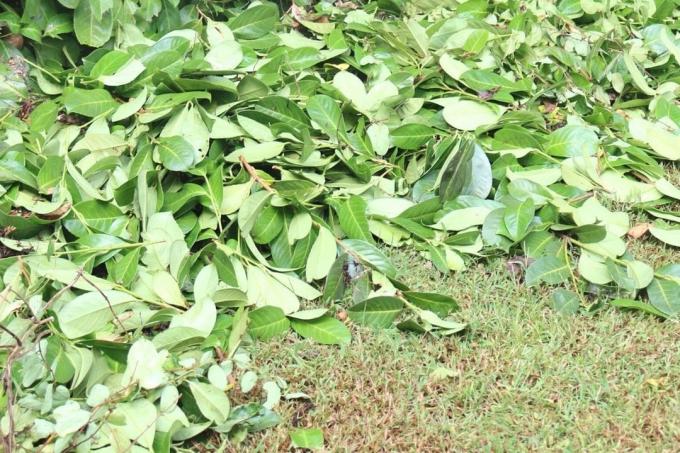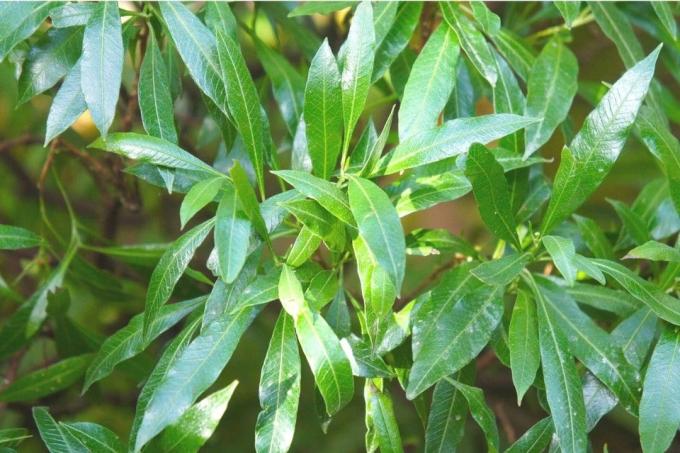
table of contents
- Cherry laurel bald
- Help through radical cutting
- Prevention through maintenance cuts
- In the spring
- In the autumn
- Frost-resistant cherry laurel varieties
- frequently asked Questions
The cherry laurel (Prunus laurocerasus) is popular as a hedge plant. The plant quickly forms high, opaque hedges. If the cherry laurel suddenly becomes bald from the inside, usually only a radical cut will help. Follow the instructions.
In a nutshell
- Frost as a common cause of internal branch death
- Radical cutting can help
- Care cuts strengthen vitality
- Cherry laurel is very easy to cut
- Frost-resistant varieties on offer
Cherry laurel bald
Cherry laurel can be seen in many gardens today. No wonder, after all, hardly any other hedge plant is as fast-growing and robust as Prunus laurocerasus. The wood with the leathery, dark green leaves, white flowers and black fruits looks attractive and grows on average twenty to forty centimeters per year.
However, a common problem is balding of the bushes from the inside. Inner branches die off in spring, especially after very cold winters.
causes
- weak plants due to lack of pruning
- frost
Help through radical cutting
If cherry laurel is balding, a radical cut can help. Always use sharp, clean hedge trimmers for cutting.
- Time: February
- Goal: rejuvenation, vitality boost

instructions
- Choose a dry, preferably sunny day for the cut.
- Cut the hedge back down to the stick.
Attention: From 1. March to 30th September is the grace period for breeding birds. During this time, trees may not be radically pruned or placed on the cane (Section 39 BNatSchG). Therefore, choose a date in February for the radical cut.
Prevention through maintenance cuts
Regular pruning measures increase vitality and can effectively prevent the balding of cherry laurel hedges. We recommend one or two maintenance cuts per year.
In the spring
- Time: beginning of March
- Goal: motivation to grow new
instructions
- For pruning, choose a dry, sunny day in March. High humidity can contribute to the development of fungal diseases. Remove any sick branches.
- Shorten older hedges by at least a third. Young hedges grow very quickly, they should be trimmed by half.

Note: The leaves of the cherry laurel are very firm. They are slow to decompose. It is better to dispose of the leaves in the bio bin than on the compost.
In the autumn
- Time: September
- Objective: topiary, protection from Diseases
instructions
- Choose a dry, sunny autumn day for pruning. Check whether leaves or parts of plants are infected with diseases. Kick frequently mildew or shotgun disease. Powdery mildew can be recognized by a whitish coating, shotgun disease by brown spots on the leaves.
- Thoroughly remove diseased plant parts and dispose of them in the household waste.
- Cut out dry, stunted branches.
- Bring the entire hedge into shape with a cut.
Note: The parts of the cherry laurel plant are poisonous and can lead to allergic reactions. Wear gloves when cutting the shrub.
Frost-resistant cherry laurel varieties
When planting the cherry laurel, rely on frost-hardy specimens from the start. These sorts get through the winter well:
- Angustifolia
- Caucasica
- Diana
- Mount Vernon
- Novita

Note: All cherry laurel plants in the tub must overwinter frost-free. Choose a suitable place in the house for this. To do this, place the bucket on an insulating surface.
frequently asked Questions
The laurel cherry also has an attractive effect as a solitary wood. A pruning is not absolutely necessary if the plant has enough space and all parts receive light. However, a pruning also has a vitality-promoting effect on individual plants. Cherry laurel bushes can also be decorated with a shape cut.
Due to the large leaves of the cherry laurel, we recommend cutting the hedge by hand. Electric hedge trimmers cause injuries to the leaves, which weaken the plant and can be entry points for pathogens.
Gardeners call the radical pruning of fruit and ornamental trees "put on the cane". It is cut back into the healthy wood. Only a few shoots remain. This radical cut is only allowed outside the breeding season of native birds. The Federal Nature Conservation Act forbids the radical cut in the period from 1. March to 30th September.

